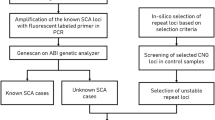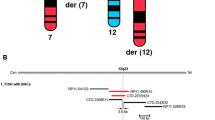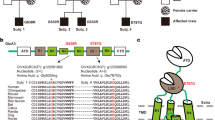Abstract
To determine the phenotypic significance of copy number changes (CNCs) in the human genome, we performed genome-wide segmental aneuploidy profiling by BAC-based array-CGH of 278 unrelated patients with multiple congenital abnormalities and mental retardation (MCAMR) and in 48 unaffected family members. In 20 patients, we found de novo CNCs composed of multiple consecutive probes. Of the 125 probes making up these probably pathogenic CNCs, 14 were also found as single CNCs in other patients and 5 in healthy individuals. Thus, these CNCs are not by themselves pathogenic. Almost one out of five patients and almost one out of six healthy individuals in our study cohort carried a gain or a loss for any one of the recently discovered microdeletion/microduplication loci, whereas seven patients and one healthy individual showed losses or gains for at least two different loci. The pathogenic burden resulting from these CNCs may be limited as they were found with similar frequencies among patients and healthy individuals (P=0.165; Fischer's exact test), and several individuals showed CNCs at multiple loci. CNCs occurring specifically in our study cohort were enriched for components of the glutamate receptor family (GRIA2, GRIA4, GRIK2 and GRIK4) and genes encoding proteins involved in guiding cell localization during development (ATP1A2, GIRK3, GRIA2, KCNJ3, KCNJ10, KCNK17 and KCNK5). This indicates that disease cohort-specific compilations of CNCs may aid in identifying loci, genes and biological processes that contribute to the phenotype of patients.
Similar content being viewed by others
Log in or create a free account to read this content
Gain free access to this article, as well as selected content from this journal and more on nature.com
or
References
Newman WG, Hamilton S, Ayres J et al: Array comparative genomic hybridization for diagnosis of developmental delay: an exploratory cost-consequences analysis. Clin Genet 2007; 71: 254–259.
Ropers HH : X-linked mental retardation: many genes for a complex disorder. Curr Opin Genet Dev 2006; 16: 260–269.
Lee JA, Lupski JR : Genomic rearrangements and gene copy-number alterations as a cause of nervous system disorders. Neuron 2006; 52: 103–121.
Nielsen J, Wohlert M : Chromosome abnormalities found among 34 910 newborn children: results from a 13-year incidence study in Arhus, Denmark. Hum Genet 1991; 87: 81–83.
Vissers LE, de Vries BB, Osoegawa K et al: Array-based comparative genomic hybridization for the genomewide detection of submicroscopic chromosomal abnormalities. Am J Hum Genet 2003; 73: 1261–1270.
Lesnik Oberstein SA, Kriek M, White SJ et al: Peters Plus syndrome is caused by mutations in B3GALTL, a putative glycosyltransferase. Am J Hum Genet 2006; 79: 562–566.
Mefford HC, Clauin S, Sharp AJ et al: Recurrent reciprocal genomic rearrangements of 17q12 are associated with renal disease, diabetes, and epilepsy. Am J Hum Genet 2007; 81: 1057–1069.
Koolen DA, Vissers LE, Pfundt R et al: A new chromosome 17q21.31 microdeletion syndrome associated with a common inversion polymorphism. Nat Genet 2006; 38: 999–1001.
Sharp AJ, Hansen S, Selzer RR et al: Discovery of previously unidentified genomic disorders from the duplication architecture of the human genome. Nat Genet 2006; 38: 1038–1042.
Cusmano-Ozog K, Manning MA, Hoyme HE : 22q13.3 deletion syndrome: a recognizable malformation syndrome associated with marked speech and language delay. Am J Med Genet C Semin Med Genet 2007; 145: 393–398.
Zweier C, Peippo MM, Hoyer J et al: Haploinsufficiency of TCF4 causes syndromal mental retardation with intermittent hyperventilation (Pitt-Hopkins syndrome). Am J Hum Genet 2007; 80: 994–1001.
Klopocki E, Schulze H, Strauss G et al: Complex inheritance pattern resembling autosomal recessive inheritance involving a microdeletion in thrombocytopenia-absent radius syndrome. Am J Hum Genet 2007; 80: 232–240.
Slavotinek AM : Novel microdeletion syndromes detected by chromosome microarrays. Hum Genet 2008; 124: 1–17.
Hand JL, Michels VV, Marinello MJ et al: Inherited interstitial deletion of chromosomes 5p and 16q without apparent phenotypic effect: further confirmation. Prenat Diagn 2000; 20: 144–148.
Sumption ND, Barber JC : A transmitted deletion of 2q13 to 2q14.1 causes no phenotypic abnormalities. J Med Genet 2001; 38: 125–127.
Barber JC : Directly transmitted unbalanced chromosome abnormalities and euchromatic variants. J Med Genet 2005; 42: 609–629.
Horvath JE, Bailey JA, Locke DP et al: Lessons from the human genome: transitions between euchromatin and heterochromatin. Hum Mol Genet 2001; 10: 2215–2223.
Iafrate AJ, Feuk L, Rivera MN et al: Detection of large-scale variation in the human genome. Nat Genet 2004; 36: 949–951.
Sharp AJ, Locke DP, McGrath SD et al: Segmental duplications and copy-number variation in the human genome. Am J Hum Genet 2005; 77: 78–88.
Sebat J, Lakshmi B, Troge J et al: Large-scale copy number polymorphism in the human genome. Science 2004; 305: 525–528.
Tuzun E, Sharp AJ, Bailey JA et al: Fine-scale structural variation of the human genome. Nat Genet 2005; 37: 727–732.
Conrad DF, Andrews TD, Carter NP et al: A high-resolution survey of deletion polymorphism in the human genome. Nat Genet 2006; 38: 75–81.
Hinds DA, Kloek AP, Jen M et al: Common deletions and SNPs are in linkage disequilibrium in the human genome. Nat Genet 2006; 38: 82–85.
McCarroll SA, Hadnott TN, Perry GH et al: Common deletion polymorphisms in the human genome. Nat Genet 2006; 38: 86–92.
Eichler EE : Widening the spectrum of human genetic variation. Nat Genet 2006; 38: 9–11.
Freeman JL, Perry GH, Feuk L et al: Copy number variation: new insights in genome diversity. Genome Res 2006; 16: 949–961.
McCarroll SA, Altshuler DM : Copy-number variation and association studies of human disease. Nat Genet 2007; 39: S37–S42.
Bailey JA, Gu Z, Clark RA et al: Recent segmental duplications in the human genome. Science 2002; 297: 1003–1007.
Stankiewicz P, Lupski JR : Genome architecture, rearrangements and genomic disorders. Trends Genet 2002; 18: 74–82.
Feuk L, Carson AR, Scherer SW : Structural variation in the human genome. Nat Rev Genet 2006; 7: 85–97.
Lupski JR : Genomic rearrangements and sporadic disease. Nat Genet 2007; 39: S43–S47.
Wong KK, deLeeuw RJ, Dosanjh NS et al: A comprehensive analysis of common copy-number variations in the human genome. Am J Hum Genet 2007; 80: 91–104.
Simon-Sanchez J, Scholz S, Fung HC et al: Genome-wide SNP assay reveals structural genomic variation, extended homozygosity and cell-line induced alterations in normal individuals. Hum Mol Genet 2007; 16: 1–14.
de Smith AJ, Tsalenko A, Sampas N et al: Array CGH analysis of copy number variation identifies 1284 new genes variant in healthy white males: implications for association studies of complex diseases. Hum Mol Genet 2007; 16: 2783–2794.
de Vries BB, White SM, Knight SJ et al: Clinical studies on submicroscopic subtelomeric rearrangements: a checklist. J Med Genet 2001; 38: 145–150.
Cheung VG, Nowak N, Jang W et al: Integration of cytogenetic landmarks into the draft sequence of the human genome. Nature 2001; 409: 953–958.
Coe BP, Ylstra B, Carvalho B et al: Resolving the resolution of array CGH. Genomics 2007; 89: 647–653.
Aston E, Whitby H, Maxwell T et al: Comparison of targeted and whole genome analysis of postnatal specimens using a commercially available array based comparative genomic hybridisation (aCGH) microarray platform. J Med Genet 2008; 45: 268–274.
de Pater JM, Nikkels PG, Poot M et al: Striking facial dysmorphisms and restricted thymic development in a fetus with a 6-megabase deletion of chromosome 14q. Pediatr Dev Pathol 2005; 8: 497–503.
de Pater JM, Poot M, Beemer FA et al: Virilization of the external genitalia and severe mental retardation in a girl with an unbalanced translocation 1;18. Eur J Med Genet 2006; 49: 19–27.
Poot M, Kroes HY, V D Wijst SE et al: Dandy-Walker complex in a boy with a 5 Mb deletion of region 1q44 due to a paternal t(1;20)(q44;q13.33). Am J Med Genet 2007; 143A: 1038–1044.
Poot M, Eleveld MJ, van 't Slot R et al: Proportional growth failure oculocutaneous albinism in a girl with a 6 87 Mb deletion of region 15q26.2 → qter. Eur J Med Genet 2007; 50: 432–440.
Flipsen-ten Berg K, van Hasselt PM, Eleveld MJ et al: Unmasking of a hemizygous WFS1 gene mutation by a chromosome 4p deletion of 8.3 Mb in a patient with Wolf-Hirschhorn syndrome. Eur J Hum Genet 2007; 15: 1132–1138.
Özgen HM, Staal WG, Barber JC et al: A novel 6.14 Mb duplication of chromosome 8p21 in a patient with autism and self mutilation. J Autism Dev Disord 2009; 39: 322–329.
Sharp AJ, Mefford HC, Li K et al: A recurrent 15q13.3 microdeletion syndrome associated with mental retardation and seizures. Nat Genet 2008; 40: 322–328.
Mefford HC, Sharp AJ, Baker C et al: Recurrent rearrangements of chromosome 1q21.1 and variable pediatric phenotypes. N Engl J Med 2008; 359: 1685–1699.
Ledbetter DH : Cytogenetic technology—genotype and phenotype. N Engl J Med 2008; 359: 1728–1730.
Blauw HM, Veldink JH, van Es MA et al: Copy-number variation in sporadic amyotrophic lateral sclerosis: a genome-wide screen. Lancet Neurol 2008; 7: 319–326.
Chang JT, Nevins JR : GATHER: a systems approach to interpreting genomic signatures. Bioinformatics 2006; 22: 2926–2933.
Aerts S, Lambrechts D, Maity S et al: Gene prioritization through genomic data fusion. Nat Biotechnol 2006; 24: 537–544.
Franke L, van Bakel H, Fokkens L et al (2006) Reconstruction of a functional human gene network, with an application for prioritizing positional candidate genes. Am J Hum Genet 78: 1011–1025.
Cuscó I, Medrano A, Gener B et al: Autism-specific copy number variants further implicate the phosphatidylinositol signaling pathway and the glutamatergic synapse in the etiology of the disorder. Hum Mol Genet 2009; 18: 1795–1804.
Snel B, Lehmann G, Bork P et al: STRING: a web-server to retrieve and display the repeatedly occurring neighbourhood of a gene. Nucleic Acids Res 2000; 28: 3442–3444.
Redon R, Ishikawa S, Fitch KR et al: Global variation in copy number in the human genome. Nature 2006; 444: 444–454.
Merla G, Howald C, Henrichsen CN et al: Submicroscopic deletion in patients with Williams-Beuren syndrome influences expression levels of the nonhemizygous flanking genes. Am J Hum Genet 2006; 79: 332–341.
Reymond A, Henrichsen CN, Harewood L et al: Side effects of genome structural changes. Curr Opin Genet Dev 2007; 17: 381–386.
Hochstenbach R, van Binsbergen E, Engelen J et al: Array analysis and karyotyping: workflow consequences based on a retrospective study of 36 325 patients with idiopathic developmental delay in the Netherlands. Eur J Med Genet 2009; e-pub ahead of print 9 April 2009.
Koolen DA, Sharp AJ, Hurst JA et al: Clinical and molecular delineation of the 17q21.31 microdeletion syndrome. J Med Genet 2008; 45: 710–720.
Acknowledgements
We kindly acknowledge the help of Hylke M Blauw, Jan H Veldink and Leonard H van den Berg (Department of Neurology, University Medical Centre Utrecht) with the processing of the data set.
Author information
Authors and Affiliations
Corresponding author
Additional information
Supplementary Information accompanies the paper on European Journal of Human Genetics website (http://www.nature.com/ejhg)
Supplementary information
Rights and permissions
About this article
Cite this article
Poot, M., Eleveld, M., van 't Slot, R. et al. Recurrent copy number changes in mentally retarded children harbour genes involved in cellular localization and the glutamate receptor complex. Eur J Hum Genet 18, 39–46 (2010). https://doi.org/10.1038/ejhg.2009.120
Received:
Revised:
Accepted:
Published:
Issue date:
DOI: https://doi.org/10.1038/ejhg.2009.120
Keywords
This article is cited by
-
Autism and intellectual disability in a patient with two microdeletions in 6q16: a contiguous gene deletion syndrome?
Molecular Cytogenetics (2016)
-
Interstitial 11q deletion: genomic characterization and neuropsychiatric follow up from early infancy to adolescence and literature review
BMC Research Notes (2014)
-
7q36 deletion and 9p22 duplication: effects of a double imbalance
Molecular Cytogenetics (2013)
-
Copy number variation in the porcine genome inferred from a 60 k SNP BeadChip
BMC Genomics (2010)
-
Glutamate receptors and learning and memory
Nature Genetics (2010)



